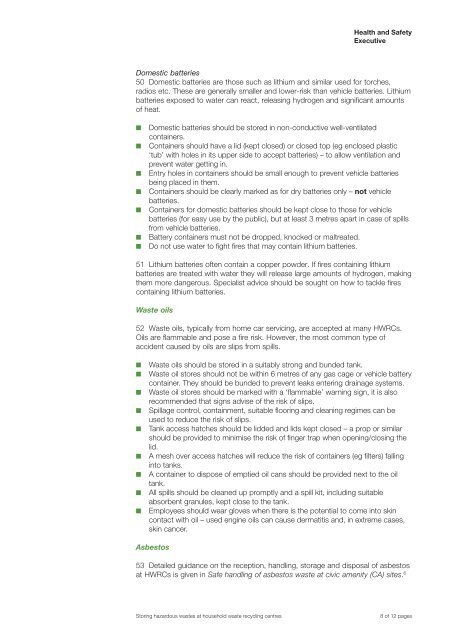Storing hazardous wastes at household waste recycling centres - HSE
Storing hazardous wastes at household waste recycling centres - HSE
Storing hazardous wastes at household waste recycling centres - HSE
Create successful ePaper yourself
Turn your PDF publications into a flip-book with our unique Google optimized e-Paper software.
Health and Safety<br />
Executive<br />
Domestic b<strong>at</strong>teries<br />
50 Domestic b<strong>at</strong>teries are those such as lithium and similar used for torches,<br />
radios etc. These are generally smaller and lower-risk than vehicle b<strong>at</strong>teries. Lithium<br />
b<strong>at</strong>teries exposed to w<strong>at</strong>er can react, releasing hydrogen and significant amounts<br />
of he<strong>at</strong>.<br />
■■<br />
■■<br />
■■<br />
■■<br />
■■<br />
■■<br />
■■<br />
Domestic b<strong>at</strong>teries should be stored in non-conductive well-ventil<strong>at</strong>ed<br />
containers.<br />
Containers should have a lid (kept closed) or closed top (eg enclosed plastic<br />
‘tub’ with holes in its upper side to accept b<strong>at</strong>teries) – to allow ventil<strong>at</strong>ion and<br />
prevent w<strong>at</strong>er getting in.<br />
Entry holes in containers should be small enough to prevent vehicle b<strong>at</strong>teries<br />
being placed in them.<br />
Containers should be clearly marked as for dry b<strong>at</strong>teries only – not vehicle<br />
b<strong>at</strong>teries.<br />
Containers for domestic b<strong>at</strong>teries should be kept close to those for vehicle<br />
b<strong>at</strong>teries (for easy use by the public), but <strong>at</strong> least 3 metres apart in case of spills<br />
from vehicle b<strong>at</strong>teries.<br />
B<strong>at</strong>tery containers must not be dropped, knocked or maltre<strong>at</strong>ed.<br />
Do not use w<strong>at</strong>er to fight fires th<strong>at</strong> may contain lithium b<strong>at</strong>teries.<br />
51 Lithium b<strong>at</strong>teries often contain a copper powder. If fires containing lithium<br />
b<strong>at</strong>teries are tre<strong>at</strong>ed with w<strong>at</strong>er they will release large amounts of hydrogen, making<br />
them more dangerous. Specialist advice should be sought on how to tackle fires<br />
containing lithium b<strong>at</strong>teries.<br />
Waste oils<br />
52 Waste oils, typically from home car servicing, are accepted <strong>at</strong> many HWRCs.<br />
Oils are flammable and pose a fire risk. However, the most common type of<br />
accident caused by oils are slips from spills.<br />
■■<br />
■■<br />
■■<br />
■■<br />
■■<br />
■■<br />
■■<br />
■■<br />
■■<br />
Waste oils should be stored in a suitably strong and bunded tank.<br />
Waste oil stores should not be within 6 metres of any gas cage or vehicle b<strong>at</strong>tery<br />
container. They should be bunded to prevent leaks entering drainage systems.<br />
Waste oil stores should be marked with a ‘flammable’ warning sign, it is also<br />
recommended th<strong>at</strong> signs advise of the risk of slips.<br />
Spillage control, containment, suitable flooring and cleaning regimes can be<br />
used to reduce the risk of slips.<br />
Tank access h<strong>at</strong>ches should be lidded and lids kept closed – a prop or similar<br />
should be provided to minimise the risk of finger trap when opening/closing the<br />
lid.<br />
A mesh over access h<strong>at</strong>ches will reduce the risk of containers (eg filters) falling<br />
into tanks.<br />
A container to dispose of emptied oil cans should be provided next to the oil<br />
tank.<br />
All spills should be cleaned up promptly and a spill kit, including suitable<br />
absorbent granules, kept close to the tank.<br />
Employees should wear gloves when there is the potential to come into skin<br />
contact with oil – used engine oils can cause derm<strong>at</strong>itis and, in extreme cases,<br />
skin cancer.<br />
Asbestos<br />
53 Detailed guidance on the reception, handling, storage and disposal of asbestos<br />
<strong>at</strong> HWRCs is given in Safe handling of asbestos <strong>waste</strong> <strong>at</strong> civic amenity (CA) sites. 6<br />
<strong>Storing</strong> <strong>hazardous</strong> <strong><strong>waste</strong>s</strong> <strong>at</strong> <strong>household</strong> <strong>waste</strong> <strong>recycling</strong> <strong>centres</strong><br />
8 of 12 pages

















